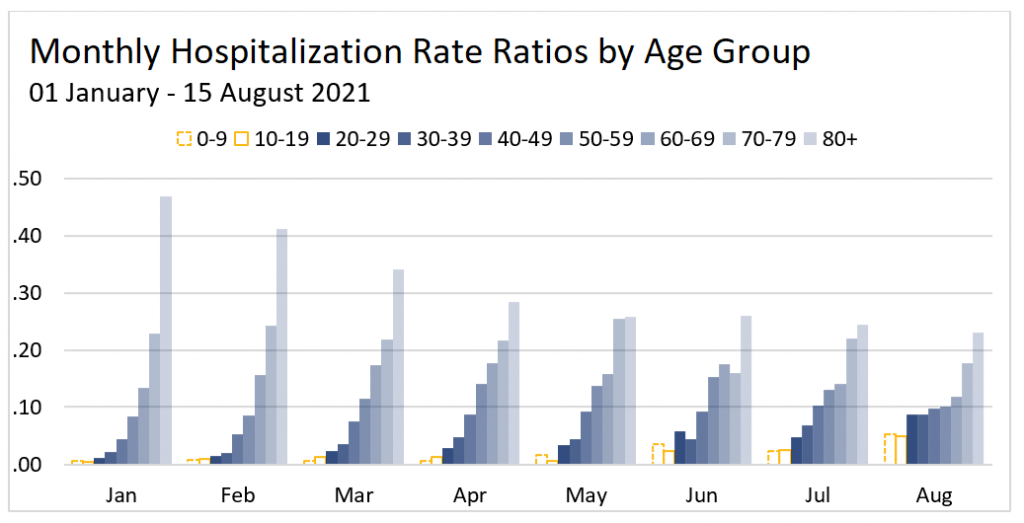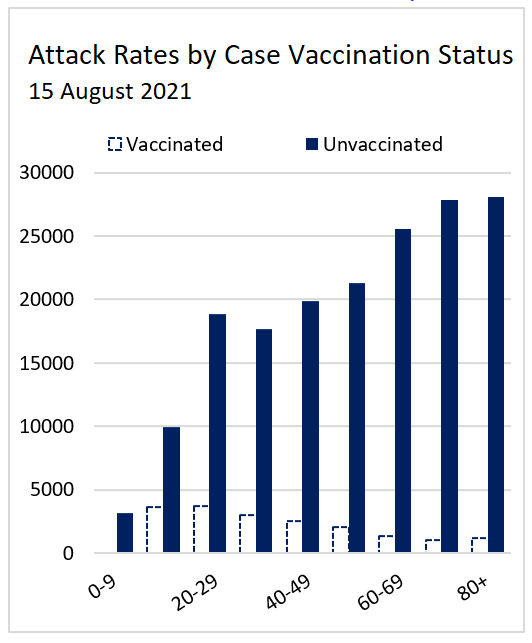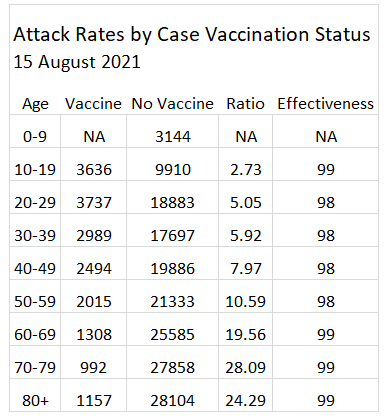Last Updated: October 19, 2021
COVID-19 vaccinations are preventing severe illness and deaths among Virginians who have received their shots. At the same time, the highly contagious Delta variant has become the main strain of the virus in Virginia and the United States. Many factors affect the direction the pandemic takes, including new variants that emerge and their effect on vaccine effectiveness, vaccination rates, seasonal changes, and the acceptance and use of other mitigation strategies, like physical distancing and community masking. Some factors reduce the spread of the virus, while others increase it. As these factors interact, trends in how the virus spreads and who is most affected can change as well.
Most recently, there has been a shift in health outcomes by age group. COVID-19 causes more severe disease in older age groups. Fortunately, high rates of vaccination among Virginians 65 and older means a reduced risk of severe COVID-19 disease. However, hospitalization rates are now increasing in younger age groups that have lower vaccination rates. 83% of those 65+ have been vaccinated, compared to 18% of those under the age of 18. The upward trend in hospitalizations among younger age groups can be observed in figure 1.1 below:

Rate ratios are used in epidemiology to compare the severity of disease across different groups. They take into account differences in the groups’ characteristics, such as age. Rate ratios are calculated as follows:
Rate per age group = (number of monthly hospitalizations / population) * 100,000
Rate ratio per age group = rate for age group / overall rate
In the beginning of January 2021, the rate ratios for people 19 years and younger were very low. The older the age group, the higher the rate ratio of hospitalizations. Recently, the rate ratio for people ages 0-9 and 10-19 has changed and it is now increasing. Young people are being hospitalized at a higher rate than they were earlier in the pandemic.
Attack rates can also help us understand the degree to which different age groups are protected from the virus. A recent blog post on Vaccine Effectiveness outlines the methodology for this and what attack rates mean.
In Virginia, COVID-19 attack rates among unvaccinated people are much higher than for vaccinated people. It is also important to note that some breakthrough cases are expected, as no vaccine is one hundred percent effective. Vaccinated people are experiencing COVID-19 attack rates in the low thousands per 100k, while unvaccinated people, and especially people in older age groups, have attack rates of twenty to thirty thousand per 100,000 persons.


Figure 1.2 – Attack Rates by Vaccination Status1,2 Figure 1.3 – Attack Rates by Case Vaccination Status Table
Further research is needed to study the impact of COVID-19 on younger age groups. However, recent studies have shown that COVID-19 vaccination prevents severe health outcomes such as hospitalization and death. Getting vaccinated reduces the risk for everyone and protects children who are not yet eligible for the vaccine.
_____________________________
- The number of unvaccinated people is overestimated due to the exclusion of federal doses and lack of interstate data on vaccine administration.
- This data is preliminary and subject to change.
- Vaccine effectiveness figures were updated 19/10/2021 due to an error, with no impact on content or analysis.

